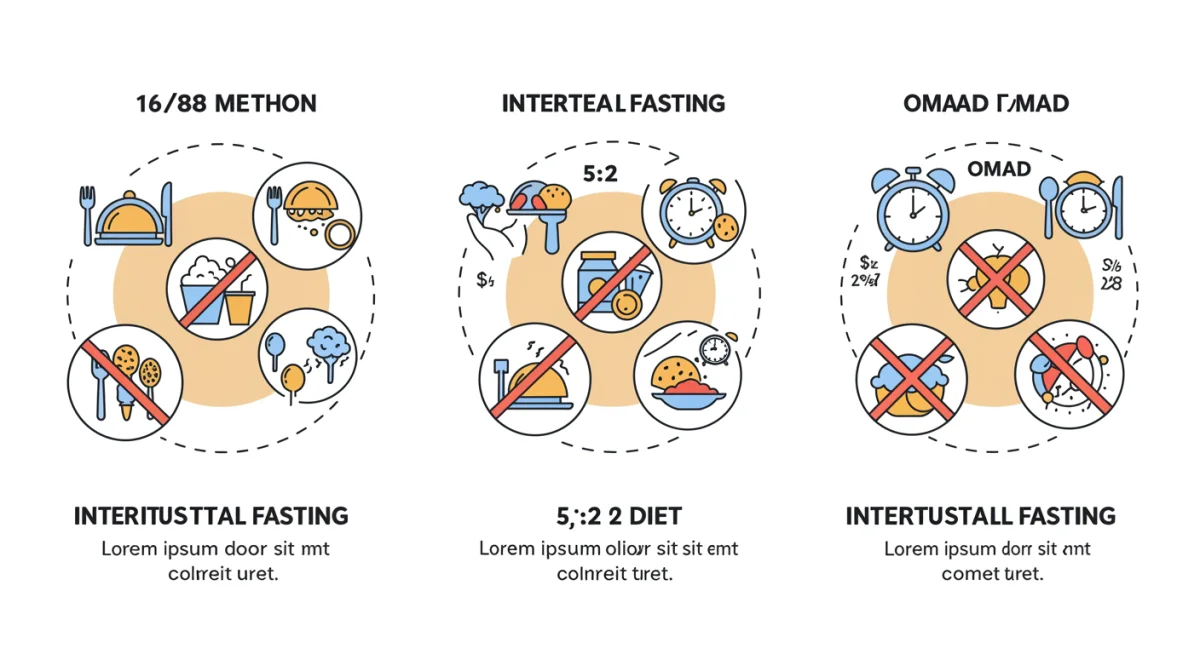Intermittent Fasting 2025: Benefits, Practices & Updates

Intermittent fasting in 2025 is recognized as an evolving nutritional strategy, offering a range of health benefits from metabolic improvements to enhanced cellular repair, with new research refining best practices for diverse individual needs and goals.
As we navigate the ever-evolving landscape of health and wellness, The Latest on Intermittent Fasting: A 2025 Nutritional Perspective on Benefits and Best Practices (RECENT UPDATES, COMPARISON/ANÁLISE) continues to capture significant attention. This dietary approach, centered on timed eating and fasting cycles, has moved beyond a mere trend to establish itself as a legitimate area of scientific inquiry and practical application. But what does 2025 tell us about its efficacy, safety, and optimal implementation? Let’s delve into the updated science and practical advice.
Understanding the Evolution of Intermittent Fasting in 2025
Intermittent fasting, often abbreviated as IF, is not a diet in the traditional sense, but rather an eating pattern that cycles between periods of eating and voluntary fasting. While its roots can be traced back centuries for religious or cultural reasons, its resurgence in modern health discourse began in the early 21st century, primarily driven by research into its potential metabolic benefits. In 2025, the understanding of IF has matured, moving from generalized recommendations to a more nuanced appreciation of its diverse forms and individualized responses.
Early discussions often focused solely on weight loss, but contemporary research highlights a broader spectrum of physiological adaptations. These include improved insulin sensitivity, enhanced cellular repair processes like autophagy, and potential benefits for brain health. The scientific community continues to explore these mechanisms, refining our comprehension of how IF impacts the human body at a molecular level.
The Scientific Backing: Beyond Calorie Restriction
While calorie restriction has long been the cornerstone of weight management, intermittent fasting offers a unique pathway to metabolic health that extends beyond simply eating fewer calories. The periods of fasting trigger specific cellular and hormonal changes that are distinct from continuous calorie restriction.
- Autophagy Activation: Fasting promotes autophagy, a cellular self-cleaning process that removes damaged cells and regenerates newer, healthier ones. This process is crucial for cellular longevity and disease prevention.
- Insulin Sensitivity: By reducing the frequency of insulin spikes, IF can significantly improve insulin sensitivity, which is vital for preventing and managing type 2 diabetes.
- Growth Hormone Secretion: Fasting can lead to an increase in human growth hormone (HGH) levels, which supports fat loss and muscle preservation.
These physiological shifts contribute to a more holistic approach to health, suggesting that the timing of food intake is as important as the quantity and quality of food consumed. The 2025 perspective emphasizes these intricate biological interactions, moving beyond a simplistic view of IF as just another weight loss tool.
The evolution of research has also brought a greater emphasis on personalized approaches. What works for one individual may not be optimal for another, underscoring the need for careful consideration of personal health status, lifestyle, and goals. This personalized aspect is a key differentiator in the 2025 understanding of intermittent fasting, moving away from a one-size-fits-all mentality.
Popular Intermittent Fasting Protocols in 2025
The landscape of intermittent fasting protocols has diversified considerably, offering various approaches to suit different lifestyles and preferences. In 2025, while new variations emerge, several core methods remain popular due to their established efficacy and ease of integration into daily life. Understanding these protocols is crucial for anyone considering IF.
Each protocol has its own set of guidelines, but the underlying principle of cycling between eating and fasting periods remains consistent. The choice of protocol often depends on individual goals, tolerance levels, and daily routines, highlighting the importance of flexibility and adaptation.
The 16/8 Method: A Timeless Favorite
The 16/8 method, also known as the Leangains protocol, involves fasting for 16 hours each day and restricting your eating to an 8-hour window. This is perhaps the most widely adopted and studied form of intermittent fasting due to its relatively manageable schedule. For many, it simply means skipping breakfast and having lunch as their first meal.
- Ease of Adoption: It aligns well with typical daily schedules, making it easier for beginners to implement.
- Flexibility: The 8-hour eating window can be adjusted to fit personal routines, such as 12 PM to 8 PM or 1 PM to 9 PM.
- Sustainable: Its less restrictive nature often leads to better long-term adherence compared to more intensive protocols.
The 16/8 method has shown consistent results in studies related to weight loss, improved metabolic markers, and enhanced cellular repair. Its sustained popularity in 2025 is a testament to its effectiveness and user-friendliness, making it a strong starting point for many individuals.
The 5:2 Diet: Fasting on Select Days
The 5:2 diet, or the Fast Diet, involves eating normally for five days of the week and restricting calorie intake to 500-600 calories on two non-consecutive days. This approach allows for greater flexibility in meal planning on non-fasting days, which can be appealing to those who find daily fasting challenging.
Research indicates that the 5:2 diet can be effective for weight management and improving various health markers, similar to daily time-restricted eating. The key is to ensure nutrient-dense food choices on both fasting and non-fasting days to support overall health. The 2025 perspective emphasizes the importance of nutritional quality, not just caloric restriction, on the two fasting days to avoid nutrient deficiencies.
Alternate-Day Fasting (ADF) and OMAD (One Meal A Day)
Alternate-Day Fasting (ADF) involves fasting every other day, either by consuming no calories or a very limited number (around 500 calories). OMAD, or One Meal A Day, is a more intensive form where individuals consume all their daily calories within a single, usually large, meal. These protocols are often considered more advanced and may not be suitable for everyone.
While ADF and OMAD can lead to significant weight loss and metabolic improvements, they require careful planning to ensure adequate nutrient intake and prevent potential side effects. These methods are typically recommended for individuals with prior experience in IF or under professional guidance. The 2025 understanding emphasizes gradual progression towards these more extreme forms of fasting, ensuring the body adapts safely.
Benefits of Intermittent Fasting: A 2025 Perspective
The benefits of intermittent fasting extend far beyond simple weight loss. As research progresses, a more comprehensive understanding of its physiological impacts has emerged. In 2025, these benefits are increasingly recognized for their potential to promote long-term health and mitigate the risk of chronic diseases.
The science points to a multifaceted approach where caloric restriction, combined with the timing of food intake, creates a synergistic effect that positively influences various bodily systems. This holistic view is central to the modern appreciation of IF.
Metabolic Health and Weight Management
One of the most well-documented benefits of IF is its positive impact on metabolic health. By allowing the body to enter a fasted state, it promotes fat burning and improves insulin sensitivity, crucial factors for weight management and preventing metabolic syndrome.
- Fat Loss: Fasting encourages the body to switch from burning glucose to burning stored fat for energy, leading to a reduction in body fat.
- Insulin Regulation: Reduced frequency of eating leads to lower and more stable insulin levels, preventing insulin resistance.
- Improved Lipid Profile: Some studies suggest IF can improve cholesterol levels, reducing LDL (bad) cholesterol and increasing HDL (good) cholesterol.
The 2025 perspective highlights that while weight loss is a common outcome, the underlying metabolic improvements are perhaps even more significant for long-term health. These changes contribute to a more efficient and resilient metabolic system.
Cellular Repair and Longevity
Beyond metabolic benefits, intermittent fasting has garnered attention for its role in cellular repair processes, particularly autophagy. This cellular housekeeping mechanism is vital for maintaining cellular health and is increasingly linked to longevity.
When the body is in a fasted state, it initiates autophagy, clearing out damaged cellular components and regenerating new ones. This process is thought to protect against various age-related diseases, including neurodegenerative disorders and certain cancers. The 2025 research continues to explore the intricate connections between IF, autophagy, and healthy aging, suggesting that periods of fasting can be a powerful tool for promoting cellular resilience.

Brain Health and Inflammation Reduction
Emerging research in 2025 also points to the potential cognitive benefits of intermittent fasting. Studies suggest that IF can enhance brain function by promoting the growth of new neurons, increasing brain-derived neurotrophic factor (BDNF), and protecting against neurodegenerative diseases.
Furthermore, IF has been shown to reduce systemic inflammation, a key contributor to many chronic diseases. By modulating immune responses and reducing oxidative stress, fasting can create an environment conducive to overall health and well-being. These anti-inflammatory effects are a significant area of ongoing research, with promising implications for managing conditions like arthritis and cardiovascular disease.
Best Practices for Intermittent Fasting in 2025
While the benefits of intermittent fasting are compelling, successful and sustainable implementation requires adherence to best practices. In 2025, the emphasis is on a safe, personalized, and nutritionally sound approach to IF, ensuring that individuals reap the rewards without compromising their health.
It’s not just about when you eat, but also what you eat during your eating windows, and how you prepare your body for fasting periods. A holistic approach is always recommended.
Prioritizing Nutritional Quality During Eating Windows
The success of intermittent fasting heavily relies on the quality of food consumed during eating periods. Fasting is not an excuse to indulge in unhealthy, processed foods. Instead, it’s an opportunity to optimize nutrient intake.
- Whole Foods Focus: Emphasize nutrient-dense whole foods, including fruits, vegetables, lean proteins, and healthy fats.
- Hydration: Maintain excellent hydration throughout both fasting and eating windows. Water, black coffee, and herbal teas are generally permitted during fasting.
- Balanced Meals: Ensure that your meals provide a balanced macronutrient profile to support energy levels and satiety.
The 2025 nutritional perspective stresses that the effectiveness of IF is significantly enhanced when paired with a diet rich in vitamins, minerals, and fiber. This prevents nutrient deficiencies and supports overall metabolic function.
Listening to Your Body and Gradual Adaptation
Intermittent fasting is not a one-size-fits-all approach. It’s crucial to listen to your body’s signals and adapt the fasting protocol to your individual needs and tolerance. Starting gradually is key to sustainable success.
Begin with shorter fasting windows, such as 12 hours, and gradually increase the duration as your body adapts. Pay attention to how you feel, noting any signs of fatigue, irritability, or excessive hunger. If you experience adverse effects, it’s essential to reassess your approach or consult with a healthcare professional. This adaptive and responsive methodology is a cornerstone of responsible IF practice in 2025.
Consulting Healthcare Professionals
Before embarking on any intermittent fasting regimen, particularly if you have underlying health conditions, are pregnant or breastfeeding, or are taking medications, consulting with a healthcare professional is paramount. They can provide personalized guidance and ensure that IF is a safe and appropriate choice for you.
A doctor or registered dietitian can help you tailor a fasting schedule that aligns with your health goals and minimizes potential risks. This professional oversight is a critical best practice in 2025, emphasizing safety and individualized care in nutritional interventions.
Addressing Common Concerns and Misconceptions (2025)
Despite its growing popularity, intermittent fasting is still subject to various concerns and misconceptions. In 2025, it’s important to address these issues with up-to-date scientific information, ensuring that individuals make informed decisions about their health.
Clearing up these misunderstandings is crucial for fostering a balanced and realistic view of IF, preventing unrealistic expectations or unnecessary apprehension.
Does Intermittent Fasting Lead to Muscle Loss?
A common concern is whether intermittent fasting results in muscle loss. While prolonged caloric restriction without adequate protein intake can lead to muscle catabolism, studies on IF generally indicate that it is effective for fat loss while largely preserving muscle mass, especially when combined with resistance training and sufficient protein intake during eating windows.
The key is to ensure that your eating periods include enough protein to support muscle repair and growth. Additionally, the increase in human growth hormone (HGH) during fasting periods can help protect muscle tissue. The 2025 consensus suggests that with proper nutritional planning, muscle loss is not a significant concern for most individuals practicing IF.
Is Intermittent Fasting Suitable for Everyone?
Intermittent fasting is not universally suitable. Certain populations should exercise caution or avoid IF altogether. These include pregnant or breastfeeding women, individuals with a history of eating disorders, those with certain medical conditions like type 1 diabetes, and individuals on specific medications.

Children and adolescents are also generally advised against IF due to their ongoing growth and developmental needs. The 2025 guidelines strongly recommend individualized assessment and professional consultation to determine the appropriateness of IF for specific health profiles, emphasizing a cautious and responsible approach.
Understanding the “Starvation Mode” Myth
The idea that fasting puts the body into “starvation mode,” slowing metabolism and hindering weight loss, is largely a misconception. While metabolism can slightly decrease during very prolonged fasts (several days), short-term intermittent fasting (up to 24 hours) has been shown to temporarily boost metabolism and increase fat burning.
- Metabolic Boost: During the initial hours of fasting, the body often increases norepinephrine to mobilize fat stores, leading to a temporary metabolic increase.
- Adaptation: The body is highly adaptable and adjusts to periods of food scarcity without significantly hindering metabolic rate in the short term.
- Hormonal Shifts: Favorable hormonal changes, such as increased HGH, counteract the perceived negative effects of “starvation mode.”
In 2025, the scientific community largely debunks the “starvation mode” myth in the context of typical intermittent fasting protocols, reinforcing that the body is well-equipped to handle periods of food restriction efficiently.
Intermittent Fasting and Chronic Disease Prevention in 2025
The potential of intermittent fasting to contribute to chronic disease prevention is a significant area of focus in 2025. Beyond its immediate effects on weight and metabolism, IF’s long-term impacts on cellular health and systemic inflammation suggest a broader role in reducing the risk of various ailments.
This preventative aspect underscores the value of IF as a lifestyle intervention, rather than just a short-term dietary adjustment. The cumulative benefits over time are what truly make it a compelling strategy for health maintenance.
Type 2 Diabetes and Cardiovascular Health
Intermittent fasting has shown promising results in improving markers associated with type 2 diabetes and cardiovascular disease. By enhancing insulin sensitivity and reducing insulin levels, IF can help regulate blood sugar and prevent the progression of prediabetes to full-blown type 2 diabetes.
Furthermore, its positive effects on blood pressure, cholesterol levels, and inflammatory markers contribute to a reduced risk of heart disease. The 2025 research continues to solidify IF’s role as a supportive strategy for these widespread chronic conditions, offering a non-pharmacological approach to improving patient outcomes.
Neuroprotection and Cognitive Function
The brain benefits from intermittent fasting through mechanisms such as increased neurogenesis (the growth of new brain cells) and enhanced production of brain-derived neurotrophic factor (BDNF), a protein crucial for brain health and cognitive function. These effects suggest a potential protective role against neurodegenerative diseases like Alzheimer’s and Parkinson’s.
While more long-term human studies are needed, the preliminary evidence in 2025 is encouraging, pointing towards IF as a lifestyle factor that could support cognitive resilience and delay age-related cognitive decline. This makes IF an intriguing area for research into maintaining brain health as we age.
Cancer Prevention and Adjuvant Therapy
While research is still in its early stages, some studies suggest that intermittent fasting may have a role in cancer prevention and could potentially enhance the effectiveness of conventional cancer treatments. The mechanisms include reducing insulin-like growth factor 1 (IGF-1), a hormone linked to cancer growth, and promoting autophagy which can eliminate precancerous cells.
It’s crucial to note that IF is not a cure for cancer and should only be considered as an adjunctive therapy under strict medical supervision. The 2025 perspective is one of cautious optimism, with ongoing clinical trials exploring IF’s potential in oncology, particularly in improving treatment tolerance and efficacy.
Integrating Intermittent Fasting into a Healthy Lifestyle (2025)
For intermittent fasting to be truly effective and sustainable, it must be viewed as an integral part of a broader healthy lifestyle. In 2025, this integration is paramount, emphasizing that IF is a complementary tool rather than a standalone solution for health and wellness.
A holistic approach, combining IF with other healthy habits, yields the most profound and lasting benefits. This means considering diet, exercise, sleep, and stress management alongside your fasting regimen.
The Synergy of IF with Exercise
Combining intermittent fasting with a regular exercise routine can amplify its benefits. Exercise, particularly resistance training, helps preserve muscle mass during weight loss and improves insulin sensitivity, complementing the effects of IF.
- Optimized Fat Burning: Exercising in a fasted state can potentially increase fat utilization for energy.
- Muscle Preservation: Resistance training ensures that weight loss primarily comes from fat, not muscle.
- Enhanced Metabolic Health: The combination leads to superior improvements in glucose metabolism and insulin sensitivity.
The 2025 guidance suggests timing workouts strategically within or around eating windows to maximize performance and recovery, ensuring that exercise and fasting work in harmony for optimal health outcomes.
Sleep and Stress Management: Unsung Heroes
Adequate sleep and effective stress management are critical for the success of any health intervention, including intermittent fasting. Poor sleep can disrupt hunger hormones and increase cravings, making fasting more challenging. Chronic stress can elevate cortisol levels, which can counteract the metabolic benefits of IF.
Prioritizing 7-9 hours of quality sleep per night and incorporating stress-reducing practices like meditation or yoga are essential. These factors create an optimal physiological environment, supporting the body’s ability to adapt to fasting and maximize its positive effects. The 2025 holistic view of health firmly places sleep and stress management as foundational elements alongside nutrition and exercise.
Long-Term Sustainability and Flexibility
For intermittent fasting to deliver lasting benefits, it must be sustainable in the long run. This requires flexibility and the willingness to adapt your fasting schedule to life’s demands. There will be days when strict adherence isn’t possible, and that’s perfectly acceptable.
The goal is not perfection, but consistency over time. Understanding that IF is a flexible eating pattern, not a rigid diet, allows for greater adherence and enjoyment. The 2025 perspective encourages a pragmatic approach, where IF fits into your life, rather than your life revolving around IF, fostering a healthy and balanced relationship with food and well-being.
| Key Aspect | Brief Description |
|---|---|
| Evolving Understanding | IF now seen as a nuanced approach with varied protocols and personalized responses, moving beyond just weight loss. |
| Key Benefits | Includes enhanced metabolic health, cellular repair (autophagy), improved insulin sensitivity, and potential brain health. |
| Best Practices | Prioritize nutrient-dense foods, listen to your body, adapt gradually, and consult healthcare professionals. |
| Holistic Integration | Combine IF with exercise, adequate sleep, and stress management for optimal, sustainable health outcomes. |
Frequently Asked Questions About Intermittent Fasting in 2025
In 2025, the 16/8 method (fasting for 16 hours, eating in an 8-hour window) and the 5:2 diet (normal eating for five days, restricted calories for two) remain the most popular due to their flexibility and proven efficacy for many individuals.
Yes, beyond weight loss, intermittent fasting is increasingly recognized for improving metabolic health, enhancing insulin sensitivity, promoting cellular repair through autophagy, and potentially benefiting brain health and reducing inflammation.
During eating windows, focus on nutrient-dense whole foods including lean proteins, healthy fats, fruits, vegetables, and whole grains. Prioritizing nutritional quality maximizes the benefits of intermittent fasting and supports overall health.
Pregnant or breastfeeding women, individuals with a history of eating disorders, those with type 1 diabetes, or anyone on specific medications should avoid IF or consult a healthcare professional before starting.
Short-term intermittent fasting typically boosts metabolism and preserves muscle mass, especially when combined with adequate protein intake and resistance training. The “starvation mode” myth is largely debunked in the context of common IF protocols.
Conclusion
In 2025, intermittent fasting has solidified its position as a scientifically supported and highly adaptable approach to health and wellness. It’s no longer just a fleeting trend but a nuanced dietary pattern offering a spectrum of benefits, from significant metabolic improvements and weight management to enhanced cellular repair and potential protection against chronic diseases. The key to successful and sustainable IF lies in understanding its diverse protocols, prioritizing nutritional quality during eating windows, listening to your body’s unique needs, and integrating it holistically with other healthy lifestyle components like exercise, adequate sleep, and stress management. As research continues to evolve, the emphasis remains on personalized approaches and professional guidance, ensuring that intermittent fasting is implemented safely and effectively to foster long-term well-being for a diverse population.





